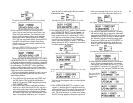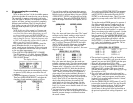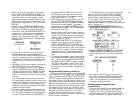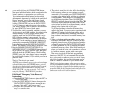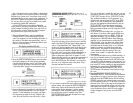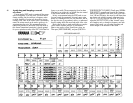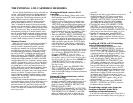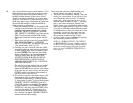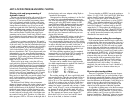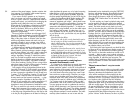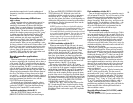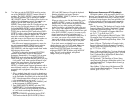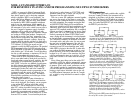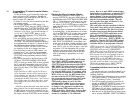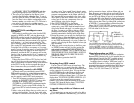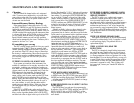ADVANCED PROGRAMMING NOTES
Playing style and programming of
dynamic control
By now you should be familiar with some of the ways
the DX7's keyboard can be programmed to be touch
responsive. If you have read the programming instruc-
tions in this manual and tried to create or edit voices,
you are probably aware of the wide range of sensitivity
settings that are available to you. If not, you can still
experience a good deal of this flexibility by playing the
presets. Excellent preset examples can be found in the
DX7 VOICE ROM
#
3 Master Group, including Electric
Piano, and Jazz Guitar. Flexibility and variety in pro-
gramming can be virtues, if used wisely When it comes
to programming the touch response of the instrument,
there is more to consider than "how wide a range can I
obtain?"
Consistency is a primary consideration. We speak of
consistency in terms of your playing style, not the sound
of the voice itself. Use your ears to determine how loud
or bright a sound is created in relation to how forcefully
you play the keyboard. If you strive to program your
voices so the keyboard "plays" similarly the DX7 will
take on a characteristic "feel." If you program each voice
independently you may never become accustomed to
the keyboard because it will behave like many different
instruments. You'll make your job much easier if you
program the DX7 to sound like many different instru-
ments, but to play like one.
When you set out to create a voice that will have
touch sensitivity (Keyboard Velocity Sensitivity and/or
After Touch modulation sensitivity), we recommend that
you work on it while playing and listening at moderate
volume levels. Program the parameters for a mellow,
almost pianissimo sound. Then, when you hit the keys
hard, the voice will have "somewhere to go." Of course,
you have to use some judgement because if you set
things too low to begin with, you provide enough "head
room" in the instrument so that a vigorous "fortissimo"
chord could saturate a tape recording or damage a
speaker system.
The Keyboard Level Scaling is also an important
adjunct to dynamic playing style in that it can be used to
change the output level when you play with the same
touch at different areas of the keyboard. The human ear
tends to be more sensitive to higher frequencies, and
the DX7 normally creates equally intense sound across
its entire keyboard so the net result is that higher notes
can sound too loud or shrill. Therefore, it is often desir-
able to program a -EXP or -LIN curve on the right side of
the break point, and to use adequate scaling Depth to
"smooth out" the response.
One approach to achieving consistency is to first find
or create a few voices whose keyboard response you
like. Then document the FUNCTION mode modulation
settings as well as the EDIT mode's settings for LFO
(speed, PMD and AMD), Modulation Sensitivity (ampli-
tude and/or pitch), Keyboard Rate Scaling, and Key-
board Velocity Sensitivity settings. Then try to use
settings in this same general range for most of your
voices. Naturally there will be exceptions, but at least
this will give you a framework which suits your own
playing style and taste.
The envelope generator (EG) settings can also have a
signficant effect on the playing response of the key-
board. If the envelope attacks are slow and you're play-
ing a staccatto passage, the notes may not fully develop
— or you may find yourself tending to slow your playing
in order to hear the sound you want. In this case, it
would be worthwhile to reprogram the attack rate, or to
add some Keyboard Rate Scaling if the problem is pri-
marily at the upper end of the keyboard.
All of the preceding suggestions may be completely
inappropriate if you are using the DX7 for creating spe-
cial effects. Then you may want odd level scaling,
extreme touch sensitivity and so forth.
Additional envelope considerations
Two notes can be sounded from a single keystroke
(for double-tongued trumpet or mandolin like sounds) if
the envelope is programmed as follows:
L1 = 99 (high) R1 = 99 (fast)
L2 = 20 Qow) R2 = 35 (slow)
L3 = 95 (high) R3 = 90 (fast)
L4 = 0 (off) R4 = 50 (not critical)
The resulting envelope will have a rapid initial attack
upon pressing the key Then the sound begins falling to
Level 2, which will sound like zero even if it is set as
high as 30 or so. The sound then jumps rapidly to Level
3, at which it sustains as long as the key is held down.
However, if you release the key as soon as Level 3 is
attained, the sustain is truncated and you hear a "double
attack" sound. If Level 2 is set at an intermediate point,
say between 40 and 60, the double attack still works.
but the effect is as though Rate 2 and Rate 3 were sped
up. This apparent rate increase occurs because R2
doesn't have to fall to as low a level, and R3 doesn't
have as far to climb, so the time is reduced.
You can simulate an ADSR if you set the envelope as
follows: L1 =99, L2=99, L4=0, and R2=99. With these
settings, then R1 becomes Attack time, R3 is Decay
time, L3 is Sustain level, and R4 is Release time.
To get the "whap" sound of brass, try using [VOICE
INIT]
Then, from the
initialized
voice, leave OP1
as
it
is. Change from ALG 1 to ALG 2, change from Feed-
back=0 to Feedback=7. and then bring up the OP2
output level to 75. This produces the modulation you
need for brass, but not the "whap," Reset OP2 EG Rate 1
from 99 to 70, which causes the modulation to "ramp
up," rapidly increase the harmonics and produce the
characteristic brass attack sound.
Delayed turn-on usiing the envelopes
If you want the Operator attack to begin a while after
you press the key, there are two approaches. One way is
to set the first level (L1) to 99, and to set the attack rate
to a low number (0 to 30). This will result in a gradual
turn-on of the note, with almost no sound at first. If you
want an abrupt (fast) attack, but you don't want it to start
for a while after the key is pressed, you'll need to take a
second approach. Set EG Level 1 to 0; Rl should be set
to 99. Then set Level 2 to 0, and set Rate 2 to achieve
whatever delay time you want. Be sure you press the
key long enough while programming these delayed
turn-on envelopes... it can take over a half a minute
before you hear anything. Set Level 3 to 99 (or some
reasonably high level), and set Rate 3 for whatever
attack time you want on the note. Level 4 should be 0,
and Rate 4 can be set to whatever release rate you
desire.
How to select an algorithm
There are 32 algorithms; all have the same 6 opera-
tors and one feedback loop, yet each algorithm is capa-
ble of creating sounds that the others cannot. Sometimes
the differences between algorithms are negligible, yet at
times the difference can be dramatic. It may help you to
picture a voice as a the result of two interactive ele-
ments, (1) the algorithm, and (2) the frequencies and
relative level of the operators within that algorithm.
An algorithm is nothing more or less than an arrange-
ment of operators. Ultimately, there are just two ways
that the operators can be connected: (1) side by side for
additive synthesis, and (2) one on top of the other for
frequency modulation. "Branching" where one operator
feeds or is fed by two or three other operators, is just a
51



